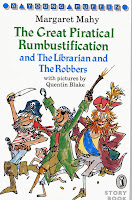By Jennifer Farrar, Soumi Dey, Yan Zheng and Osman Coban (PhD students, School of Education, University of Glasgow)
Try
this for a tongue twister: readers like reading about other readers reading.
Not tricky enough? What about: reading about reading is as important as reading
itself. Okay, so the second one isn’t as much of an alliterative challenge, but
it does paraphrase a key point raised by Evelyn Arizpe at the beginning of the
day-long Reading Fictions symposium, held in Glasgow in October. Quoting from
Maria Nikolajeva’s contribution to the project, Evelyn asked us to consider how
readers, the act of reading and books themselves are represented in children’s
literature in English. What messages about reading do books bring to the
reading process? And, to get all tongue-twisty again, can reading about reading
– or even readers reading – have an impact on the way we feel about reading, as
readers ourselves?
According
to Vivienne Smith, many ‘real’ readers find it flattering to read about the
pleasure fictional readers get from books, not simply because it affirms the
values that may already be attached to literacy practices, but also because
such ‘bookish’ characters are often linked to goodness and virtue. Are we, as real readers, drawn moth-like to
representations of fellow book lovers (even if other characters seem to think
they are a bit boring) because we subconsciously connect with their love of
books? As Vivienne suggested, are we more likely to empathise with a
character-reader when their right to read is removed – as it is for Demetria in
Jan Mark’s Riding Tycho (2005), or Felix in Morris Gleitzman’s Once (2005) – even if it is only one right among many? Does being a reader
intensify the sympathy we would ordinarily feel for their plight? [You’ll have noticed
our use of ‘we’ and the automatic assumptions we have made about the readers of
this blog.] Similarly, authors such as
Cornelia Funke, who represents books symbolically as keys and weapons, tap into
long-held (and highly prized) assumptions about books as repositories of
knowledge, as places of intellectual fortitude and endurance. As Maureen
Farrell explained during her paper on the representation of reading in young
adult fantasy, such texts positively revel in their intertextuality and often draw
heavily upon a reader’s metafictive awareness.
But
what about those readers who are not already so strongly “book-identified”, to
borrow a term from Maureen’s paper: will such self-reflexive texts seem a bit
daunting? Or could they possibly inspire wider reading? During her discussion
of Leon Garfield’s The Book Lovers
(1976), Kimberley Reynolds showed how Garfield’s creation of a character who
creates a canon of books about love, all for the purposes of wooing, could at
once encourage some readers to broaden their literary horizons, while
alienating others.
Linked
to this sense of broadening was Julia Eccleshare’s discussion of Jacqueline
Wilson, which explored how Wilson’s relationship with her readers is reflected
in her books. Several of her texts feature Wilson-like writer-characters, who
spend a great deal of time encouraging young people from all kinds of
backgrounds to engage with literacy as a meaningful hobby or career choice. As
Julia explained, the parallels between Wilson’s real life activities (her
commitment to engaging with as many readers as possible) and the values
expressed by her writer-characters will not be lost on her fans, who, it would
be hoped, might go onto espouse Wilson’s generous and inclusive views on
literacy.
Moving
further afield, Evelyn’s paper explored a set of books that depict illiterates
(both human and animal) as vermin who can only exist on the margins of society.
Developing the ability to read within such oppressive conditions can be
transformative: the characters are described as filthy until they learn to
read, when they become symbolically cleansed. Here, the reader can still be
flattered by the presentation of reading as akin to cleanliness, but this time,
we must empathise with characters who cannot (yet) read; who are not (yet)
members of our reading club. As Evelyn explained, such texts may encourage
readers to reflect on a life without access to reading, as well as literacy’s
life-enhancing potential.
Similar
representations emerged during Jean Webb’s paper on Marcus Zusak’s The Book Thief (2008), where books and
reading are linked to freedom, persecution and death. Liesel, who cannot read,
goes to sleep with a treasured copy of The
Grave Digger’s Handbook under her pillow, a book that she learns to read as
the story develops and new relationships form. Her newly-discovered passion for
reading comes at a time when books are being burnt in their thousands. Here,
books, readers and the act of reading are linked to life-affirming notions of
comfort, love and safety within challenging, changing times.
Of
course, changing times can mean changing text types, as Sylvia Warnecke
explored during her paper on digital fictions. Teaching digital texts like Inanimate Alice, could provide teachers
with exciting opportunities to discuss what counts as reading: after all, the
texts that Alice seems to derive most comfort from are the ‘texts’ sent to her
by a friend via his mobile device. The discussions linked to this paper raised
interesting questions about how different types of reading are perceived, and
how they may be embraced in a modern classroom.
So,
it would seem that we all agreed that, as readers, reading about reading is
important because of the powerful messages it can convey. And indeed, what
better place to start reading about reading than in the early years, with contemporary
picturebooks. As Morag Styles and Mary Ann Wolpert demonstrated during their whistle-stop
tour of the genre, metafictive texts such as Jon Scieszka and Lane Smith’s The Stinky Cheeseman and Other Fairly Stupid
Tales (1992) riotously exploit (and explode) assumptions about how, where
and why we read. Not only that, but they are hilarious too.
Papers
from the Symposium are to be published in an edited volume, more details on
this when available.














